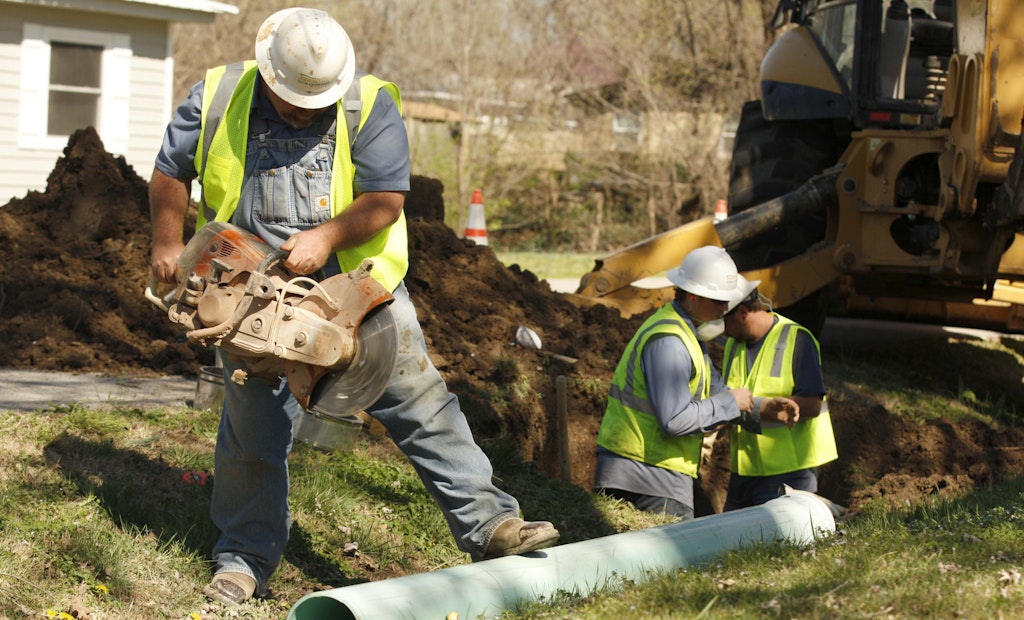
Wayne Smith cuts a length of pipe to repair a sewer line for the Fayetteville (Arkansas) Water Department. (Photo by Bruce E. Stidham)
Interested in Infrastructure?
Get Infrastructure articles, news and videos right in your inbox! Sign up now.
Infrastructure + Get AlertsPopulation growth is a critical issue for city planners and water/wastewater utility leaders in some areas of the country. Whether it’s vigilant pursuit of grant funding, changes in local regulations for new development, customer education on water conservation or embracing new technologies, municipalities dealing with exploding populations have a lot to think about.
Brunswick County, North Carolina, for instance, has been in the top 30 U.S. counties for population growth over the last decade, mostly because it’s one of the few places in the nation where golfers can play the sport they love year round. But a 40 percent population increase between each of the last four census counts translates to an increased demand for water from Brunswick County Public Utilities.
“The latest chamber of commerce figures say we’re adding about 3,500 people each year,” says John Nichols, assistant director for BCPU. “And our system’s been growing. We take on new customers every year, plus we’ve taken over several smaller systems in the county and brought them up to our higher standards.”
Those high standards have helped BCPU get recognized as Large Distribution System of the Year by the North Carolina chapter of the American Water Works and Water Environment associations numerous times. But awards only go so far when new development shows no sign of slowing down.
When new development is built in Brunswick County, water infrastructure is the responsibility of the developers and is subject to inspection and approval. BCPU has extended lines as needed to accommodate this growth. “We refined and quantified our materials specs and design standards in 2010,” says Jerry Pierce, director of Public Utilities. “That’s eliminated a lot of problems with new builds.”
BCPU has two water treatment plants with a total capacity of 30 mgd. Demand averages 13.56 mgd, and the peak to date was 25.99 mgd. That’s a lot of excess capacity, but BCPU is planning ahead for growth. Likewise with wastewater: Six treatment plants have been built with a total capacity of 10.855 mgd. They’ve been averaging 5.76 mgd with a 7.42 mgd peak.
And demand for water has been kept to a minimum thanks to customer education about household water use via media, bill inserts and the BCPU website. Any new builds are required to use water-saving fixtures.
Leaning on technology
The sewer and water utility of Fayetteville, Arkansas, has another approach when it comes to dealing with population growth: Keeping up with tech developments.
“Northwest Arkansas is continuing to grow,” says Fayetteville Utilities Director Tim Nyander. Fayetteville is one of four cities clustered in the area that together account for half a million people.
“Over 20 people are moving in per day to the area,” he says. “The challenge for everybody is capacity (on both the water and sewer systems). We’re in good shape there, but we just have to keep a mindful eye.”
That’s why keeping up with new developments in technology is so important, says Nyander. “It’s a commitment of the utility to incorporate new technology in our practices. There’s a fine line between being a leader and being a guinea pig. We always want to use tried-and-true methods, but at the same time we want to be on the leading-edge in technology.”
For example, just as Fayetteville embraced CIPP lining on the sewer side, it’s looking at trenchless rehabilitation options on the water main side, says Operations Manager Mark Rogers. The utility recently purchased a directional boring machine from Vermeer.
“It saves a lot of time and a lot of money in some cases, especially in the historic district of the city where you can’t really tear up the roads,” Nyander says.
Even as Fayetteville looks forward to continued improvement, it’s also looking back to make sure the lessons it learned over 20 years of working to eliminate SSOs are not forgotten. As Nyander puts it, “There are a lot of places where we don’t need to reinvent the wheel. We just need to continue going on.”





